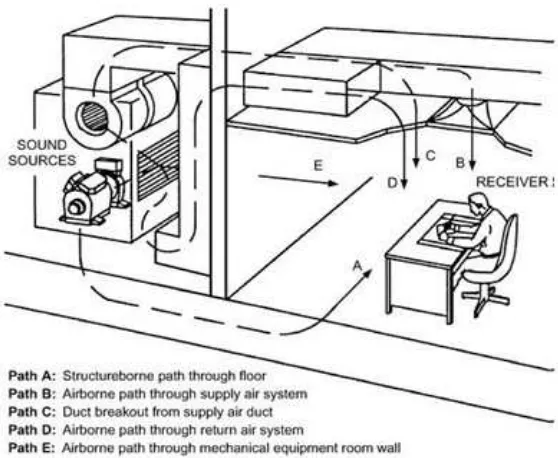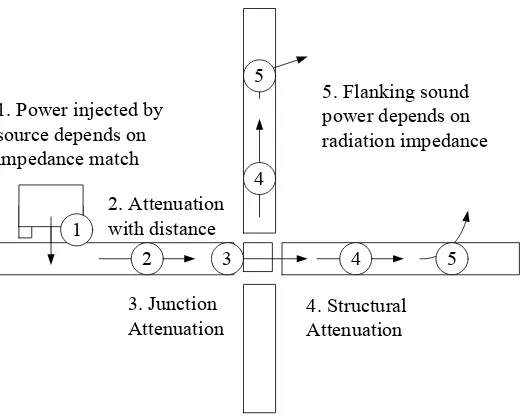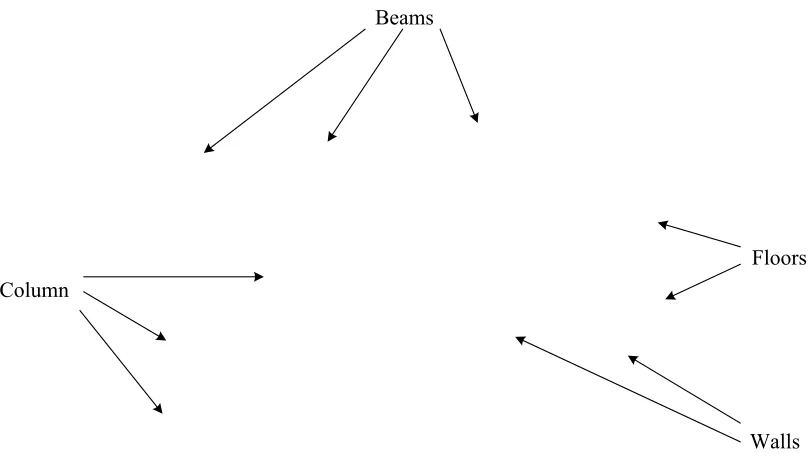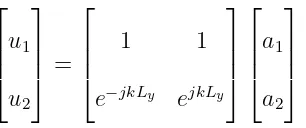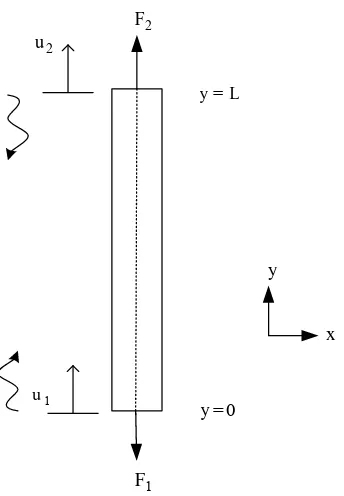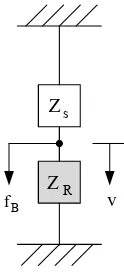Faculty of Mechanical Engineering
MODELING OF VIBRATION TRANSMISSION AND
PREDICTION OF STRUCTURE-BORNE NOISE IN BUILDINGS
CHEAH YEE MUN
Master of Science in Mechanical Engineering
MODELING OF VIBRATION TRANSMISSION AND PREDICTION OF STRUCTURE-BORNE NOISE IN BUILDINGS
CHEAH YEE MUN
A thesis submitted
in fulfillment of the requirements for the degree of Master of Science in Mechanical Engineering
Faculty of Mechanical Engineering
UNIVERSITI TEKNIKAL MALAYSIA MELAKA
DECLARATION
I declare that this thesis titled, ’Modeling of vibration transmission and prediction of structure-borne noise in buildings’ is the result of my own research except as cited in the references. The Thesis has not been accepted for any degree and is not currently submitted in candidate of any other degree.
APPROVAL
I hereby declare that I have read this thesis and in my opinion this thesis is sufficient in terms of scope and quality for the award of Master of Science in Mechanical Engineering
DEDICATION
”Be kind whenever possible. It is always possible.”
ABSTRACT
ABSTRAK
ACKNOWLEDGEMENTS
First and foremost, I would like to give sincere tribute to my supervisor, Dr. Azma Putra. I have been fortunate to have an advisor who gave me the freedom to explore. At the same time he has provided me detailed guidance and encouragement throughout the research. I appreciate the countless amount of times he spent having to solve, reflect and advise me in regards to the problems which surfaced during this research.
I am also grateful for the support by Prof. David Thompson (ISVR, University of Southampton). His expert advice and constructive suggestion during the planning and development of this research work are greatly acknowledged.
Furthermore, I would like to thank my colleagues in the ’Vibro-Acoustic Research Group’, for giving suggestions, sharing knowledge and providing ideas which gave valuable input to enrich my work. My appreciation goes to the staff of Department of Mechanical Engineering, UTeM for their kindness and patience.
Most importantly, none of this would have been possible without the love and for-bearance of my family. A special thank you to my fiance, Aroon Seelan, for believing in me and sharing my wish to reach the goal of completing this master. I would also like to express my heart-felt gratitude to my extended family who have encouraged me throughout this endeavor.
TABLE OF CONTENTS
PAGE
DECLARATION i
APPROVAL ii
DEDICATION iii
ABSTRACT iv
ABSTRAK v
ACKNOWLEDGEMENT vi
LIST OF TABLES x
LIST OF FIGURES xi
LIST OF ABBREVIATIONS xvi
LIST OF PHYSICAL CONSTANT xvii
LIST OF SYMBOLS xviii
LIST OF PUBLICATIONS xx
CHAPTER xx
1 INTRODUCTION 1
1.1 Background 1
1.2 Problem statement 2
1.3 Objective 3
1.4 Methodology 4
1.5 Scope of study 4
1.6 Thesis outline 5
2 LITERATURE STUDY 7
2.1 Introduction 7
2.2 Past findings on noise generation and transmission 7 2.2.1 Vibration transmission through building structures 9
2.2.1.1 Analytical methods 9
2.2.1.2 Numerical methods 11
2.3 Governing equation 15 2.3.1 Fundamental of structural waves 15 2.3.2 Longitudinal wave motion in columns 16
2.3.3 Bending waves in beams 19
2.3.4 Input power of multiple contact points 22
2.3.5 Statistical Energy Analysis 25
2.4 Measurement parameters 27
2.4.1 Vibration parameters 27
2.4.2 Acoustics parameters 28
2.5 Summary 29
3 METHODOLOGY 30
3.1 Introduction 30
3.2 Development of analytical model for a two-dimensional (2D) portal frame
model 32
3.2.1 Simple portal frame model 32
3.2.1.1 Ground-borne force 35
3.2.1.2 Force acting at the mid-span of the beam 36 3.2.2 Operating deflection shapes (ODS) 41
3.2.3 Two-floors portal frame model 43
3.2.4 Influence of bending in columns 47
3.2.5 Soil dynamics 50
3.3 Development of numerical model for a three-dimensional (3D) portal frame
model 56
3.4 Development of a numerical model for sound pressure level prediction 58
3.4.1 FE subsystems 58
3.4.2 SEA subsystems 59
3.4.3 Hybrid FE/SEA Model 60
3.5 Experimental work 62
3.5.1 Portal frame experiment 62
3.5.2 Measurement of structural response 65
3.5.3 Reception plate experiment 67
3.5.4 General equation of structure-borne power 68 3.5.5 Preparation of reception plate method 68
3.5.6 Reception plate mobility 68
3.5.7 Spatial velocity of the plate response 69
3.6 Summary 71
4 ANALYTICAL RESULT AND ANALYSIS 72
4.1 Structural response of a two-dimensional (2D) five-floors model 72 4.2 Influence of parameters on structural response 78
4.4 Summary 86
5 EXPERIMENTAL RESULT AND ANALYSIS 87
5.1 Introduction 87
5.2 Portal frame experiment result 87
5.3 Reception plate experiment result 91
5.4 Prediction of sound pressure level 93
5.5 Influence of machine faults 96
5.6 Summary 98
6 CONCLUSION AND RECOMMENDATION 99
6.1 Conclusion 99
6.1.1 Modeling of analytical 2D portal frame model 99 6.1.2 Prediction of sound pressure level using VA One 100
6.2 Thesis contribution 100
6.3 Recommendation 101
REFERENCES 102
APPENDICES 109
A MATLAB CODES 109
A.1 Function 109
A.1.1 Column element 109
A.1.2 Beam element 109
A.1.3 Hysteretic spring element 110
A.2 2D analytical portal frame model 111
A.2.1 One-floor 111
A.2.2 Two-floors 115
A.2.3 Three-floors 121
A.2.4 Five-floors 128
B INSTRUMENTATION 144
B.1 Softwares interface 144
B.1.1 Abaqus interface 144
B.1.2 VAone interface 144
LIST OF TABLES
TABLE TITLE PAGE
LIST OF FIGURES
FIGURE TITLE PAGE
1.1 Typical paths of noise and vibration propagation from air-conditioning
sys-tems (Schaffer, 1991) 2
2.1 Five factors that control flanking transmission via floor or wall junction from the source (Adapted from Nightingale et al. (2002)). 9 2.2 (a) Quasi-static transmission of flexible foundation modes on the
superstruc-ture and (b) Flexible modes of the superstrucsuperstruc-ture with clamped foundation
(Adapted from Fiala et al. (2007)). 12
2.3 Aerial view of the Rana Plaza following the disaster 13 2.4 Rescue crews at the site of the Sampoong Super Store collapse 14 2.5 Elements in a concrete frame structure (Adapted from
www.understandconstruction.com) 16
2.6 Longitudinal waves travel in column element 19 2.7 Bending waves propagating in beam element 20 2.8 A vibrating source with (a) free velocity and (b) blocked force 23
2.9 A source connected to a receiver 24
2.10 Diagram illustrating power flow between two subsystems
(Adapted from Vigran (2008)) 26
3.1 The flowchart diagram of study methodology 31
3.2 Example of a simple frame 32
3.4 Vibration velocity level,Lν at the mid-span point due to ground-borne force
of amplitude 10 N. 36
3.5 Simply supported beam with force acting at the mid-span 36
3.6 Static equilibrium at node 2 38
3.7 Injection force slight away from the mid-span of the floor. 39 3.8 Vibration velocity level, Lν at the mid-span point due to injected force
slightly away from the mid-span of the floor. 40 3.9 ODS predicted using analytical portal frame model and FE model (a)-(b) 8.9
Hz, (c)-(d) 35.2 Hz and (e)-(f) 77.1 Hz 42
3.10 Example of a simple frame 43
3.11 Comparison of vibration velocity levelLν at each floor at the mid-span point for two-floors simple portal frame from FE model and from analytical model. 45 3.12 ODS predicted for two-floors building (a) 8.9 Hz, (b) 34.1 Hz, (c) 35.7 Hz,
(d) 68.6 Hz, (e) 79.5 Hz, (f) 94.8 Hz (g) 117.5 Hz and (h) 138.6 Hz 46 3.13 Influence of bending in columns in portal frame 47 3.14 Influence of bending in columns for vibration velocity levelLν at each floor
at the mid-span point for two-floors simple portal frame using analytical
ap-proach 48
3.15 ODS predicted for two-floors building: (a), (c) and (e) no bending in column and (b), (d), and (f) under the influence of bending 49 3.16 Example of a portal frame building with two-floors and dynamic soil
charac-teristic 51
3.17 Column attached to a hysteretic damping spring element 52 3.18 Comparison of vibration velocity level Lν at each floor at the mid-span for
3.19 Comparison of vibration velocity level Lν at each floor at the mid-span for two-floors simple portal frame on different types of soil using analyti-cal model (−−without soil dynamic,−−Loose Sand, 15 MN/m2,−−Sitly
Medium Dense Sand, 30 MN/m2,−−Medium Dense Sand, 60 MN/m2and
−−Dense Sand, 120MN/m2) 54
3.20 ODS of the two-floors portal frame on different types of soil (−−without soil dynamic, −−Loose Sand, 15 MN/m2,−−Sitly Medium Dense Sand,
30MN/m2,−−Medium Dense Sand, 60 MN/m2and−−Dense Sand, 120
MN/m2) for second eigenfrequency between 14.6 to 20.6 Hz 55
3.21 Isometric view of a two floor 3D FE model. 57 3.22 SEA plates added to the FE model to complete a Hybrid FE/SEA model 61 3.23 SEA acoustic cavities added to the Hybrid FE/SEA model 61 3.24 Flowchart of study experimental work 63 3.25 Scaled model building (a) portal frame and (b) dimensions of the model. 64 3.26 Experiment setup for mobility measurement using instrumental hammer 66 3.27 Flowchart diagram of reception plate experiment 67 3.28 Experiment setup for mobility measurement on reception plate 69 3.29 Experiment setup for spatial velocity measurement on the reception plate 70
4.1 Example of a portal frame to simulate a building with five-floors 73 4.2 Vibration velocity levelLν at each floor at the mid-span point 74 4.3 ODS predicted for five-floors building (a) 9 Hz, (b) 14.8 Hz, (c) 35.6 Hz, (d)
43.7 Hz, (e) 79.1 Hz, (f) 89.2 Hz, (g) 136 Hz and (h) 151 Hz 75 4.4 Ratio between the velocity levelLν at each floor at the mid-span point with
the vibration velocity levelLν at the top floor where the force is injected. 76 4.5 Ratio between the velocity levelLνat each floor at the column point with the
vibration velocity levelLν at the top floor where the force is injected. 77 4.6 Vibration velocity level at the mid-span position at 3rd floor using different
floor’s density values 79
4.7 Vibration velocity level at the mid-span position at 3rd floor using different
4.8 Vibration velocity level at the mid-span position at 3rd floor using different
damping loss factor for the floors 81
4.9 Vibration velocity level at the mid-span position at 3rd floor using different
damping loss factor for the columns 82
4.10 Comparison of vibration velocity levelLν at each floor at the mid-span point for two-floor simple portal frame from 3D FE model and from 2D analytical
model. 84
4.11 ODS predicted for two-floors building using 3D FE model at (a) first peak and (b) second peak at the first eigenfrequency. 85
5.1 Comparison of vibration velocity levelLν at each floor simple portal frame from−−analytical model,−FE model, and−experiment 88 5.2 Coherence of the measurement taken at each floor (a) first (b) second and (c)
third floor 89
5.3 The measured spatial average mean-squared velocity of the reception plate
(one-third octave band in red) 91
5.4 Damping loss factor of the reception plate 92 5.5 Structure-borne power of the induction motor by reception plate method 93 5.6 The predicted sound pressure level in each cavity due to the injection power
from the top floor 94
5.7 The overall pressure level of the Hybrid FE/SEA model due to the injection
power from the top floor 95
5.8 Rotating unbalance mass is added to the rotating shaft of the motor 97 5.9 Structuborne power of the induction motor at different condition by
re-ception plate method 97
5.10 The predicted sound pressure level in the upper cavity due to the injection power from motor at different condition 98
B.1 A three-floors 3D FE model using Abaqus (a) portal frame and (b) operation
B.2 A three-floors Hybrid FE/SEA model using VA One (a) portal frame model with cavities (b) power input of the induction motor using data obtained from
reception plate experiment 146
LIST OF ABBREVIATIONS
ANSI AmericanNationalStandardInstitutes BE BoundaryElement
FE FiniteElement
HVAC Heating,Ventilation andAirConditioning MATLAB MatrixLaboratory
NC NoiseCriteria
LIST OF PHYSICAL CONSTANT
Speed of sound c = 343ms−1
Velocity amplitude reference level νref = 1x10−9ms−1
LIST OF SYMBOLS
A Cross-sectional area
a1, a2 Wave
B Plate bending stiffness
E Young’s modulus
E1, E2, Et Energy
Em1, Em2 Modal energy
ǫ Strain
F Force
I Second moment of area of cross section
j =√−1 Imaginary unit
K Dynamic stiffness
k Wave number
ksp Hysteric characteristic of the soil
L Length
Lν Vibration velocity level ¨
mR Mass per unit area of the panel MR Total mass of the plate
M Moment
η Damping loss factor
η12, η21 Coupling loss factor
n1, n2 Modal density
φ Mode shape
θ Angular displacement
ρ Density
P Structure-borne sound power
t Plate thickness ¯
W Sound power
Wdiss Dissipated power Win Input power
W′ Transmitted power
W12, W21 Power flow between subsystems 1 and 2
ω Angular frequency ∆ω Frequency bandwidth
¯
YS Mobility of the source
¯
YR Mobility of the receiver ¯
Yp Point Mobility
¯
Yt Transfer mobility
ν Poisson’s ratio ¯
νp Normal velocity amplitude ¯
νSf Root mean square free velocity
X Ratio
LIST OF PUBLICATIONS
Journal Articles
Putra, A., Cheah, Y.M., Muhammad, N., Rivai, A. and Wai, C.M., (2014). The ef-fect of perforation on the dynamics of a flexible panel. Advances in Acoustics and Vibration, 2014.
Cheah, Y.M., Putra, A., Lim, K.H., Ramlan, R., and Muhammad, N., (2016). Identify-ing structure-borne noise transmission in buildIdentify-ing. International Review of Mechanical Engineering, 2016.
Proceedings
Cheah, Y.M., Putra, A., Muhammad, N. and Ramlan, R., (2015). Fundamental model of structure-borne vibration transmission in buildings using the portal frame approach. Proceedings of Mechanical Engineering Research Day 2015, MERD’15, 2015, pp.93-94.
CHAPTER 1
INTRODUCTION
1.1 Background
As a number of building service equipments, such as pumps, ventilators and air condi-tioners, emergency generators, cooling towers and mechanical parking towers are installed in buildings, inevitably, the operation induced structure-borne vibration. This can be a common noise and vibration problem in the building. Long-term exposure to the ambient noise, can lead to noise-induced stress related health effects such as depression, sorrow, social isolation and aggression (Passchier-Vermeer and Passchier, 2000). For these reasons, noise control is essential.
noise level of an unoccupied private office and conference rooms should not exceed a sound level of 35 dB(A). If the ambient noise level exceeds 35 dB(A), it will decrease intelligibility of the speech, for example, complaints of annoyance and stress can result.
The majority of noise sources come from vibrating equipment installed in the build-ing. The transmitted vibration from service equipment activates the building structures to vibrate and eventually radiate sound which causes audible low frequency noise disturbance inside the building.The vibration waves follow different paths until they reach a room inside the building as illustrated in Figure 1.1. The illustration can be seen to mostly concern the airborne path rather than the structure-borne path (Schaffer, 1991). However, in practice, the structure-borne path can also come from the connection of the duct to the wall and from the roof.
1.2 Problem statement
Over a period of time, the vibrating equipment from the machinery are capable of injecting high level vibration input power that is hazardous to the building. The structural excitation on the building does not only lead to noise pollution, but may also causes structural damage. Discussions on the structure-borne noise behavior in buildings are still progressing. Recent work regarding the structure-borne vibration mostly concentrated on determination of the ’vibration strength’ of the vibrating source (Sp¨ah and Gibbs, 2009; Ohlrich, 2011). There appears to be lack of studies regarding propagation of vibration and the noise radiation due to the vibration transmitted into the building.
Therefore, analytical and numerical analysis methods of a portal frame approach are of interest and the main discussion in this study. This study is focused on the structural response of a multi-storey portal frame building in order to understand the behavior of the structure with propagating waves. Then, in order to develop more complete models, the model is extended to include plate elements using numerical approaches. The established numerical approach employing Hybrid Finite Element and Statistical Energy Analysis is used to identify sound pressure level in the receiving room.
1.3 Objective
This study embarks on the following objective:
• To develop an analytical model for the structure-borne vibration in a building using portal frame structure approach.
• To predict the sound pressure level in the receiving room using experimental data from reception plate experiment.
1.4 Methodology
This research started by developing the analytical model using a portal frame structure approach. The result from the analytical model is then validated using Finite Element model (FE). The FE model is then expanded into three dimensional model to be used for identifying sound pressure levels in the receiving room. To complete the analysis, the model is also extended to include plate elements and the power input from the source is identified by using the reception plate technique. Later, the power is supplied into the Hybrid FE/SEA model to calculate the sound pressure level due to the transmitted vibration in the building environment.
1.5 Scope of study
1.6 Thesis outline
In this chapter, some of the background and motivation for this study has been dis-cussed. The problem is identified in this chapter. The discussion of the background also answers the aims and the scopes of the study on structure-borne vibration and noise trans-mission in building.
Chapter 2 discusses the literature reviews where established works from past re-searches are taken into account for this study. The basic background theory of longitudi-nal waves in columns and bending waves in beams are presented in this chapter. The detail formulation and assumptions of dynamic stiffness matrix for the building elements is also discussed in this chapter. The basic mathematical modeling of vibration input power for multiple contact points are also discussed in this chapter.
Chapter 3 presents the methodology of the two dimensional analytical model em-ploying the assembly procedure for both stiffness matrix of each elements. The derivation to estimate the vibration velocity level for the case of a small portal frame is also included in this chapter. This chapter also includes portal frame experiment and reception plate ex-periment. Reception plate method is used to identify the input power of the induction motor which acts as a source to the portal frame model.
Chapter 4 reviews the analytical model from Chapter 3. The simple model is then extended consisting of five-floors to simulate a real building. The two-dimensional (2D) analytical model is validated with results from a numerical model. It is useful to predict the vibration response of the structure.
the two-dimensional numerical model in Chapter 4 for a better understanding of the struc-tural behaviour. The sound pressure level in the receiving room is predicted using a Hybrid FE/SEA approach.
CHAPTER 2
LITERATURE STUDY
2.1 Introduction
In this chapter, established research work done for structural-borne vibration and noise transmission in building is reviewed. A brief principle to the theory of dynamic stiff-ness matrix approach for columns and beams is also included in this chapter. Euler-Bernoulli theory is applied to determine the bending waves in a beam element, while assuming only longitudinal waves occur in column element.
2.2 Past findings on noise generation and transmission
Heavy monolithic construction was first investigated to predict sound transmission through complete building system (Quirt, 2009). The principle of statistical energy analy-sis (SEA) is well suited for heavy monolithic construction, with structural elements such as concrete floors and masonry walls. The building elements such as floors or walls are treated as homogeneous and isotropic, where these elements are characterized at reverberant levels and most energy losses are due to adjoining elements (Craik, 1996). However, if the pro-posed system is anisotropic and highly damped, in result, the vibration levels vary across the surface of the structural assembly, which limits the applicability of simple SEA models.
On the other hand, for lightweight framed construction, study of sound transmission in Canada has focused on typical North American wood-framed building. Nightingale et al. (2002) proposed that the power flow via each flanking path is defined by five transmission factors whose combined effect is characterized by a path transfer function specific to the type of the excitation and the construction detail. Figure 2.1 shows the factors controlling the transmission of the structure-borne sound from the source to the room beside. Unlike heavy monolithic construction, the structure-borne source in lightweight construction is much more localized. Hence, in Nightingale et al. (2002) work, he suggests that direction of transmission relative to the framing members becomes an additional parameter needed for an accurate prediction.
2 3 4 5 4
5
5. Flanking sound power depends on radiation impedance 1. Power injected by source depends on impedance match
1
Figure 2.1 Five factors that control flanking transmission via floor or wall junction from the source (Adapted from Nightingale et al. (2002)).
2.2.1 Vibration transmission through building structures
There are several methods which can be used to predict structure-borne noise gen-erated by vibration through building structures. The introduction of the European standard on estimating structure-borne noise in building, EN (2009) provides methods for estimating structure-borne noise, however, due to the uncertainty in structure-borne sources, the calcu-lations are rather complex and difficult to apply (Smith, 2011).
The estimation of sound levels due to service equipment in buildings is a complex task and structure borne noise sources and transmission are not completely understood.
2.2.1.1 Analytical methods
concrete. This results in structures with inherently low damping in comparison to older buildings which are built with bricks. This phenomena also enables larger span floors with lower first resonances (Grootenhuis, 1990). Hence, these modern construction methods tend to result in buildings which are more susceptible to vibration within the frequency range of concern, typically between 5 and 200 Hz (Talbot and Hunt, 2000).
In recent years, many studies of transmission of structure-borne sound in buildings focus on buildings above railway tunnels. Ljunggren (1991) conducted the research on the transmission of structure-borne sound in buildings in the special case where the sound origi-nates from underground railway traffic. In his study, it was demonstrated that a major part of the sound is transmitted upwards in the building in the form of quasi-longitudinal waves. The model is presented based on Ketten-Leiter theory, where the load bearing walls/columns and the floor are modelled as an infinite cascade of longitudinal rods alternating with impedance elements. Ljunggren’s method was applied in Hassan (2001)’s recent work, a finite ground impedance is taken into account as well as wave reflection from the rood. As this study focused on low frequencies, from comparison between result from the approximate and the complete models, it is found that the agreement between the two models is in general fairly good for buildings with columns, but not for bearing walls.
into repeating units. The method is extended to structures that are infinitely long, thereby reducing computational times. The numerical value of damping is found not to be a critical factor on account of radiation to infinity through the structure and into the piled foundation.
2.2.1.2 Numerical methods
Lightweight constructions are progressing faster than the conventional heavy struc-ture buildings. Reliable prediction tools for noise transmission in lightweight buildings are in needs, hence analytical solutions have been established for a number of simple structures (Cremer et al., 2005). Galbrun (2010) conducted a study on modeling of vibration trans-mission through plate/beam structures typical of lightweight buildings. SEA was used as the framework of analysis for prediction, but the theories examined were independent from SEA. The result obtained indicated that simple point models are only applicable to single plate and beam system and to the parallel opposite plates connected along their center to a beam. Such application is limited to frequencies below 2 kHz. In Craik et al. (1991)’s stud-ies, it is shown that SEA is unreliable for low frequencies investigation as there are only few resonant modes. It was found that it is the modes in the receiving subsystem that affect the power flow for transmission between plates. Finite element models do not suffer from the same limitation as SEA models.
concentrated on the structure and acoustic response of a multi-storey portal frame office building up to a frequency of 150 Hz to the passage of a Thalys high-speed train at constant velocity. The method was based on the Green’s function of a layered half-space to calculate the noise radiation inside the building. Here, it is noted that the classical problem with numerical model is always the computational time. The study presented the modes of the structure and an example of the structure response is shown in Figure 2.2. According to this study, a FE/BE model, such as a tunnel, takes about five seconds per frequency in the two-dimensional case, whereas the computation time for the three-two-dimensional models is about two hours per frequency on a typical personal computer. Therefore, a full three-dimensional analysis takes approximately 1000-2000 times longer than the two dimensional analysis. In addition, this difference is increased when larger numerical models are considered.
The three story superstructure is supported by a0.3m thick reinforced concrete raft foun-dation. The basic structure consists of a reinforced concrete portal frame structure containing vertical columns of cross sectional dimensions0.3×0.3m and horizontal beams of dimen-sions 0.3×0.2 m. This frame structure supports three 0.3 m thick horizontal slabs. The structure has a reinforced concrete central core which surrounds the stair-case. The thick-ness of the core walls is0.15m. The structural model is extended with the in-fill walls of three rooms besides the core. Room 1 has dimensions5×6×3m, and is located in the first floor, behind the core wall; room 2, which has the same dimensions, is located on the second floor; a smaller room 3 with dimensions5×4×3m is located on the first floor, besides the core. The masonry in-fill walls are0.06m thick.
The finite element size is chosen as 0.25m, which is fine enough for computations up to200 Hz. The total model has85518degrees of freedom. A constant hysteretic structural damping ofβs = 0.025is assumed.
6.3.2 The modes of the structure
(a)
mode 7,3.73Hz mode 8,3.83Hz mode 100,207.61Hz
(b)
mode 2,6.66Hz mode 4,11.96Hz mode 300,131.83Hz
Figure 6.5: (a) Quasi-static transmission of flexible foundation modes on the superstructure and (b) flexible modes of the superstructure with clamped foundation.
According to the Rubin criterion [Rub75], all the modes up to1.5fmax have to be taken into account in the modal superposition in order to have a kinematic base that is sufficient up to a frequency offmax. In the present study, all the foundation and superstructure modes up to300Hz have been accounted for. A few modes are displayed in figure 6.5. The lowest mode of the superstructure with a clamped base is at2.60 Hz, and only 12 modes of the superstructure have been found under20 Hz. These low frequency modes are the global torsional and bending modes of the whole building. Above50Hz, however, the modal
den-Figure 2.2 (a) Quasi-static transmission of flexible foundation modes on the su-perstructure and (b) Flexible modes of the susu-perstructure with clamped foundation
(Adapted from Fiala et al. (2007)).
2.2.2 Characterization of structure-borne source
The transmitted vibration waves from machinery do not only lead to noise pollution, but may also be hazardous to the building structure. Structural collapses can come without any early warning sign and are difficult to predict. Recent international cases includes the Sampoong Super Store collapse in Seoul, Republic of Korea (Gardner et al., 2002) and Rana Plaza collapse in the Greater Dhaka Area, the capital of Bangladesh (Yardley, 2013). The most important causes of Sampoong Super Store collapse were the reduced slab depth and the excessive loads applied to the building due to the change of use of the space. Similiarly, the main reason of the collapse of Rana Plaza is that the building was poorly constructed. The building was initially built for commercial use and later additional three floors were added to the building to house garment factories. Large power generators placed on these upper floors produced vibration, which aggravated the building structures. Finally, even though symptoms of structural distress were evident in several locations before the collapse of the building, the people in positions of knowledge and authority took no action resulting in the death of hundreds of people.
Figure 2.3 Aerial view of the Rana Plaza following the disaster
Figure 2.4 Rescue crews at the site of the Sampoong Super Store collapse
force vector (Gardonio and Brennan, 2004). For a single contact and single component of excitation (Mondot and Petersson, 1987), the structure-borne sound powerP from a source is,
P = ReW¯=
νS¯ f
2
YS¯ + ¯YRRe ¯
whereν¯Sf is the root mean square of free velocity of the source, andYS¯ andYR¯ are the com-plex source and receiver mobility, respectively. Sp¨ah and Gibbs (2009) proposed a method for characterization of structure-borne sources based on the concept of the reception plate where the total structure-borne sound power from the machine under test is assumed equal to the power dissipated by a plate attached to the machine. The reception plate method is proposed as a laboratory test. Alber et al. (2011) also employed the reception plate method for prediction of structure-borne sound due to vibrations in taps and valves.
Bonhoff and Petersson (2009); Mathiowetz and Bonhoff (2013) focused on develop-ing mathematical models to determine the power injected by the structure-borne source to the receiving structure. However, these works only focus on determination of the ’vibration strength’ of the mechanical sources. There appears to be a lack of studies regarding propaga-tion of vibrapropaga-tion and the noise radiapropaga-tion in the space due to the vibrapropaga-tion transmitted into the building. It is essential to understand how vibration waves travel in the building structure. In the interest of understanding the behavior of the building, analytical analysis will be the first step to investigate the phenomena.
2.3 Governing equation
2.3.1 Fundamental of structural waves
Beams
Column
Floors
Walls
Figure 2.5 Elements in a concrete frame structure (Adapted from www.understandconstruction.com)
is a connected frame of members, each of which are firmly connected to each other (moment connection) in order to resist the various loads that act on a building (Allen and Iano, 2013). The concrete frame rests on foundations, which transfer the forces from the building to the ground.
2.3.2 Longitudinal wave motion in columns
one. Rather, the waves that travel in the columns are defined as quasi-longitudinal waves. According to Thomson (1993), the equation of motion of axial vibration of a column in they-direction is:
EA∂
2u(y, t)
∂y2 =ρA
∂2u(y, t)
∂t2 (2.2)
where u(y, t) is the longitudinal displacement through the column with a uniform cross-sectional areaA, Young’s modulusEand densityρ. In order to find the general solution, Eq. (2.2) is assumed for a time harmonic solution of the form:
u(y, t) = U(y)ejωt (2.3)
This allows the solution to be written as
U(y) =a1e−jky+a2ejky (2.4)
where the wave-number is defined as:
k =ω r
ρ
E (2.5)
In Eq. (2.3), a1ej(ωt−ky) is a wave varying harmonically in space and time, which
propagates in the positive y-direction. Also,a2ej(ωt+ky) is a wave varying harmonically in
Figure 2.6 illustrates the direction of the displacement and forces. The displacements at the boundaries of the element are expressed as:
whereLy is the length of the column in the direction ofy. Also, if the element is subjected to axial loadsF1 andF2, the applied forces are expressed in terms of displacement by:
F(y) =EA∂u
∂y (2.7)
then the vector of forces is expressed as:
and the dynamic stiffness is defined by:
Ku=F (2.9)
From Eq. (2.6) and (2.8), the dynamic stiffness matrix is equal to:
2
Figure 2.6 Longitudinal waves travel in column element
2.3.3 Bending waves in beams
For bending in a beam, bending waves are assumed to propagate through the beam. The equation of motion for the flexural vibration of a beam is fourth order and there are four types of free wave solution. The relative amplitudes depend on the excitation, assumed to be concentrated at the two ends, which comprises forces and moments. For wavelengths which are greater than six times the thickness of the beam (Petyt, 1990), Euler-Bernoulli beam theory can be applied. The equation of motion is:
EI∂
4u(x, t)
∂x4 +ρA
∂2u(x, t)
∂t2 = 0 (2.11)
The solution in time harmonic form can be written as:
U(x) = a1e−jkx
where the wave-number is defined as:
k =√ω
ρA EI
1 4
(2.13)
As can be seen in Eq. (2.12), a1 and a2 are the amplitudes of waves propagating in the positive and negativex-direction, wherean1andan2are the wave amplitudes of the
near-field in the regionx>0. The direction of the displacements, forces and waves can be seen in Figure 2.7.
1
F F2
2
u
1 u
0 =
x x = L
x
y
Figure 2.7 Bending waves propagating in beam element
A beam element requires two degrees of freedom at each end, translational displace-ment and rotational displacedisplace-ment. The latter is defined as:
θ(x, t) = ∂u(x, t)
Then, the vector of the degrees of freedom are is given by:
The shear force and bending moment acting on the beam are given by:
F(x) = −EI∂ 3u
∂x3 ; M(x) =EI ∂2u
∂x2 (2.16)
from which the general matrix of forces is equal to:
Hence, the dynamic stiffness matrix of a beam is the solution of:
whereI is the second moment of cross sectional area and Lx is the length of the beam in the direction of x. Many publication results include the calculation of dynamic stiffness matrix for the Euler-Bernoulli beam element. Such calculations are provided by Bishop and Johnson (2011), Gorzynski and Thornton (1974) and Warburton (1976) who surveyed the exact FE method. Unlike Timoshenko beam theory, Euler-Bernoulli beam theory does not taken into account the effects of transverse shear strain. It is suitable where beam thickness is less than1/6of the wavelength. For these reasons, Euler-Bernoulli beam theory is applied in this study.
2.3.4 Input power of multiple contact points
for receiver structure. The structure-borne sound source can be modeled into a single and multiple contact point force. Mobility is defined as the ratio of the resulting velocityνto the driving forceF at a given point (Gardonio and Brennan, 2004)
Y = ν
F (2.19)
and the impedance is the reciprocal of mobility i.e. the ratio of the forceF acting on the system to the resulting velocityνgiven as
Z = F
ν (2.20)
Considering a vibrating source has impedancezSwhich is free suspended and vibrates
with velocityνf. The velocity of the source in this case is known as ’free velocity’. Assuming the source is attached on a rigid surface as seen in Figure 2.8, the source is restrained to move at the contact point and it is now injecting force onto the surface. The force in this case is now called as ’blocked force’ which is also defined as
fB =zS.νf (2.21)
s
Figure 2.8 A vibrating source with (a) free velocity and (b) blocked force
fB =fS+fR = (zS+zR)ν (2.22)
Figure 2.9 A source connected to a receiver
while the curly sign indicates the vector.
Using Eq. (2.22) and substituting it into Eq. (2.23), this gives
Pin= 1
The input power is defined in decibels as sound power level. The scale and the reference value used in this work are listed below:
Lw = 10log10
2.3.5 Statistical Energy Analysis
Statistical Energy Analysis (SEA) has been widely used to calculate the energy flow between the connected resonant systems. It is used to predict the average values over a frequency band of interest. The local models of subsystems are described statistically and the average response of the subsystems is predicted. It has an advantage where it is suitable for modeling vibro-acoustic systems when detailed information about the system properties are not available.
The primary variable in SEA is the modal energy. The loss factor is used to charac-terize the energy loss in the subsystem and the coupling loss factors are used to characcharac-terize the power flow between the subsystems (Lyon, 2014). A simple power flow between two subsystems using SEA is illustrated in Figure 2.10. The total energy in each system is repre-sented byE1andE2, wheren1andn2are the modal density for each subsystem respectively. The input power isWinand transmitted power isW′, and the dissipated power of each system
